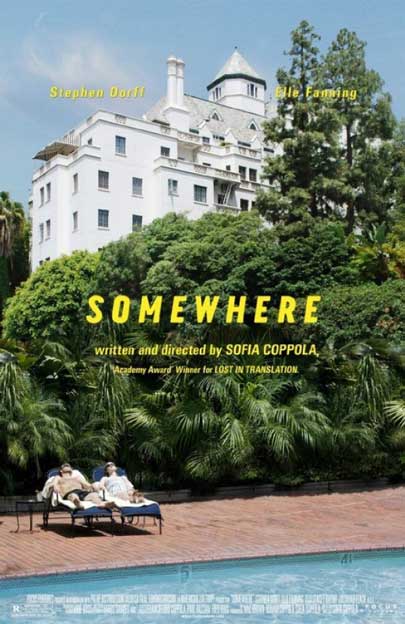The Ambiguous "Somewhere"

“Somewhere” suffers from the latter malady.
Sofia Coppola’s films have never been weighty affairs (“Lost in Translation,” “Marie Antoinette”); in fact, her films often have a translucent quality, veiling its subjects underneath a glittery sheen.
With “Somewhere,” the characters almost completely disappear into the sunny vistas, from sparkling LA to opulent Rome.
It’s easy to discern the basic storyline of the film just from the trailer: man (film star Johnny Marco, played by Stephen Dorff) lives surrounded by beautiful women and alcohol and luxury; man finds no comfort in said surroundings; man reunites with quirky, adorable daughter (Cleo, played by a wide-eyed Elle Fanning); man realizes there is more to life than carelessly indulging his hedonistic whims.
All of this is set to snippets of Phoenix’s “Love Like a Sunset” and The Strokes’ “I’ll Try Anything Once” (a demo of their later released song “You Only Live Once”), with only minor soundtrack additions in the actual film.
The barely-there soundtrack forces the viewer to focus intently on the characters and their interactions, as nothing exists to separate the viewer from the visuals of the film. And what the viewer sees is this: a whole lot of nothing.
Don’t misunderstand; as a film, “Somewhere” is gorgeous. But while some films are gorgeous in their entirety and depth, “Somewhere” is gorgeous purely frame-by-frame, a series of potential poster prints linked together only by physical film.
And while Dorff and Fanning settle into their characters gamely, and tug at each other in true father-daughter fashion, Johnny and Cleo don’t really exist outside of the relationship they have with each other.
Much of this has to do with the situation of the plot: Johnny is a Hollywood star, living in the historic Chateau Marmont hotel in Hollywood. A Don Quixote-esque fellow with a fluid harem of leggy blondes, he smokes and drinks constantly, bums around when he’s not working on films, and finds himself completely bored of it all (he falls asleep during a private pole dancing show).
Cleo, meanwhile, is his fresh-faced 11-year-old daughter. Originally a fragment of his life, only around when he has time, she suddenly becomes his responsibility after her mother basically abandons her at her father’s hotel room.
While the interactions between Johnny and Cleo are admittedly quite sweet (the room service gelato scene comes to mind), it’s difficult to summon up much real empathy for either Johnny’s or Cleo’s character. They both occupy a stratospheric level of wealth and luxury, and Johnny in particular takes advantage of his prestige.
The visuals of the film follow down this same excessive vein of vanity: gratuitous shots of topless women abound, and the camera spends a lot of time on Dorff’s rugged, tattooed torso. There are moments of connection with the characters, such as when Cleo tries to explain the plot of “Twilight” to her bemused father, but by the end of the film, nothing really comes out of the film.
Unlike some of Coppola’s previous features, the hollowness of the film’s content doesn’t prove anything, except that Johnny is deeply unhappy (a fact underlined by the many shots of his many prescriptions).
In “Lost in Translation,” the film’s ambiguous plot and ending fascinated and teased viewers into caring about the fate of those two lost souls. “Somewhere” just leaves the viewer in a state of pity for both Johnny and his much-in-need-of-love daughter.
“Somewhere” begins with a shot of a black Ferrari driving in endless circles around a dusty, otherwise empty track: a vehicle moving for the sake of moving, without any real progression. The same could be said for the film itself.
Reach Lilian here.
Join our mailing list.



